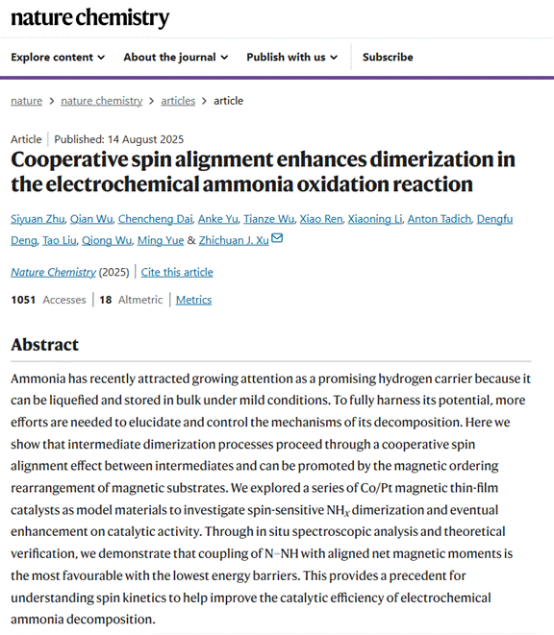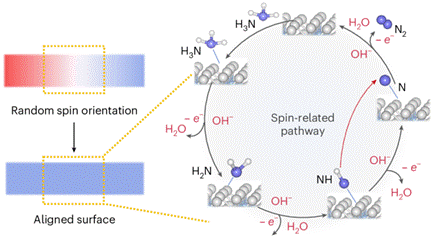Recently, Associate Professor Zhu Siyuan from the School of Energy Storage Science and Engineering of our university cooperates with the research team led by Professor Xu Zhichuan from Nanyang Technological University, Singapore, to publish a research paper entitled "Cooperative spin alignment enhances dimerization in the electrochemical ammonia oxidation reaction" in the international top journal Nature Chemistry (DOI: 10.1038/s41557-025-01900-1). For the first time, this study reveals how cooperative spin effects regulate the key dimerization process in the electrochemical ammonia oxidation reaction for hydrogen production, offering a brand-new perspective on the efficient conversion of hydrogen energy.

As an important hydrogen energy carrier, ammonia boasts its advantages such as convenient storage and transportation as well as high energy density, playing a crucial role in the future hydrogen energy economy. However, in the process of ammonia cracking directly into hydrogen, the ammonia oxidation reaction (AOR) is bottlenecked by sluggish reaction kinetics. Although platinum-based catalysts can enhance the activity, the dimerization pathway and mechanism of their intermediates have long been controversial, becoming a key factor restricting technological development.
To address this, the research team innovatively designed a multilayer Co/Pt magnetic thin-film catalyst and introduced a magnetization-induced strategy to achieve cooperative spin alignment between the surface and intermediates. Experimental results show that the cooperative spin effect can significantly reduce the reaction energy barrier for the dimerization of nitrogen-containing intermediates, thereby accelerating the reaction rate. Combined with density functional theory calculations, the study further reveals the optimal reaction pathway and the precise regulation mechanism of magnetic domain structure on reaction activity. This achievement not only facilitates the understanding of the reaction mechanism in the ammonia oxidation and decomposition process but also opens up a new ideas for introducing spin regulation into multi-electron complex reaction systems.

This research closely aligns with China's strategic demand for hydrogen production amid the large-scale development of renewable energy, and holds great significance for advancing efficient and low-carbon hydrogen energy conversion technologies. Based on the discipline construction and platform resources of School of Energy Storage Science and Engineering, this achievement not only demonstrates our university's sustained innovation capability in the frontier field of hydrogen energy and strong strength in high-level international cooperation, but also signifies that our university's research in energy storage-related directions has reached the international leading level.
As the most influential flagship chemistry journal under Springer Nature, Nature Chemistry is renowned for publishing original, groundbreaking and interdisciplinary research findings, with its 2024 Journal Impact Factor (JIF) reaching 20.2. The successful publication of this achievement marks a new important breakthrough in our university's hydrogen energy research.